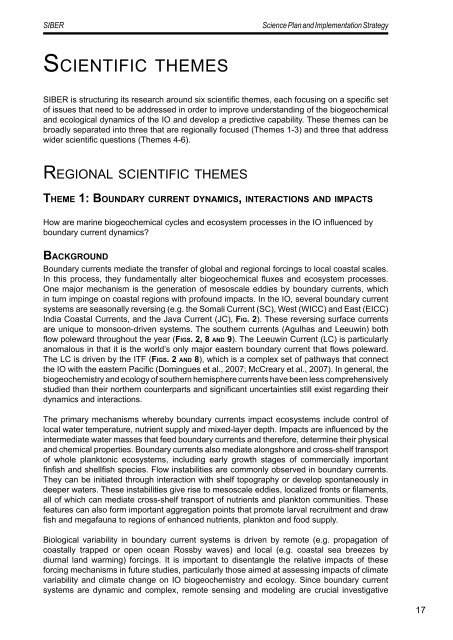SIBER SPIS sept 2011.pdf - IMBER
SIBER SPIS sept 2011.pdf - IMBER
SIBER SPIS sept 2011.pdf - IMBER
You also want an ePaper? Increase the reach of your titles
YUMPU automatically turns print PDFs into web optimized ePapers that Google loves.
<strong>SIBER</strong><br />
Science Plan and Implementation Strategy<br />
Scientific th e m e s<br />
<strong>SIBER</strong> is structuring its research around six scientific themes, each focusing on a specific set<br />
of issues that need to be addressed in order to improve understanding of the biogeochemical<br />
and ecological dynamics of the IO and develop a predictive capability. These themes can be<br />
broadly separated into three that are regionally focused (Themes 1-3) and three that address<br />
wider scientific questions (Themes 4-6).<br />
Re g i o n a l scientific t h e m e s<br />
Th e m e 1: Bo u n d a r y c u r r e n t d y n a m i cs, i n t e r a c t i o ns a n d i m p a c ts<br />
How are marine biogeochemical cycles and ecosystem processes in the IO influenced by<br />
boundary current dynamics<br />
Ba c k g r o u n d<br />
Boundary currents mediate the transfer of global and regional forcings to local coastal scales.<br />
In this process, they fundamentally alter biogeochemical fluxes and ecosystem processes.<br />
One major mechanism is the generation of mesoscale eddies by boundary currents, which<br />
in turn impinge on coastal regions with profound impacts. In the IO, several boundary current<br />
systems are seasonally reversing (e.g. the Somali Current (SC), West (WICC) and East (EICC)<br />
India Coastal Currents, and the Java Current (JC), Fig. 2). These reversing surface currents<br />
are unique to monsoon-driven systems. The southern currents (Agulhas and Leeuwin) both<br />
flow poleward throughout the year (Fi gs. 2, 8 a n d 9). The Leeuwin Current (LC) is particularly<br />
anomalous in that it is the world’s only major eastern boundary current that flows poleward.<br />
The LC is driven by the ITF (Fi gs. 2 a n d 8), which is a complex set of pathways that connect<br />
the IO with the eastern Pacific (Domingues et al., 2007; McCreary et al., 2007). In general, the<br />
biogeochemistry and ecology of southern hemisphere currents have been less comprehensively<br />
studied than their northern counterparts and significant uncertainties still exist regarding their<br />
dynamics and interactions.<br />
The primary mechanisms whereby boundary currents impact ecosystems include control of<br />
local water temperature, nutrient supply and mixed-layer depth. Impacts are influenced by the<br />
intermediate water masses that feed boundary currents and therefore, determine their physical<br />
and chemical properties. Boundary currents also mediate alongshore and cross-shelf transport<br />
of whole planktonic ecosystems, including early growth stages of commercially important<br />
finfish and shellfish species. Flow instabilities are commonly observed in boundary currents.<br />
They can be initiated through interaction with shelf topography or develop spontaneously in<br />
deeper waters. These instabilities give rise to mesoscale eddies, localized fronts or filaments,<br />
all of which can mediate cross-shelf transport of nutrients and plankton communities. These<br />
features can also form important aggregation points that promote larval recruitment and draw<br />
fish and megafauna to regions of enhanced nutrients, plankton and food supply.<br />
Biological variability in boundary current systems is driven by remote (e.g. propagation of<br />
coastally trapped or open ocean Rossby waves) and local (e.g. coastal sea breezes by<br />
diurnal land warming) forcings. It is important to disentangle the relative impacts of these<br />
forcing mechanisms in future studies, particularly those aimed at assessing impacts of climate<br />
variability and climate change on IO biogeochemistry and ecology. Since boundary current<br />
systems are dynamic and complex, remote sensing and modeling are crucial investigative<br />
17












